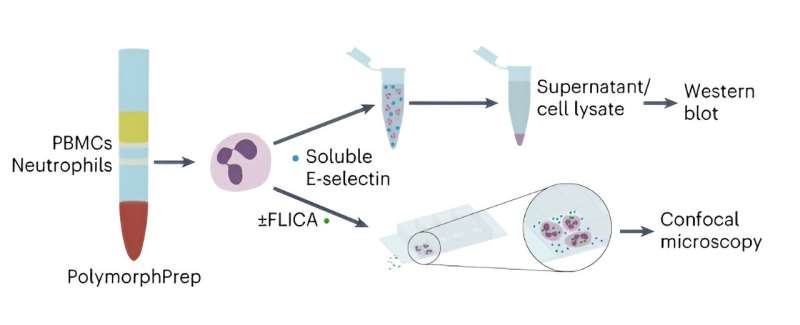This article has been reviewed according to Science X's editorial process and policies. Editors have highlighted the following attributes while ensuring the content's credibility:
fact-checked
peer-reviewed publication
trusted source
proofread
Researchers reveal mechanisms of alarmin release at an early stage of immune reaction

Many common diseases such as arteriosclerosis and diabetes or neurodegenerative diseases such as Alzheimer's are associated with inflammatory processes. A better understanding of these processes is therefore an important building block for the development of new therapeutic options.
Certain immune cells, so-called neutrophils, play a crucial role in the initiation and maintenance of inflammatory processes in the blood and tissue. When activated, these release inflammatory messenger substances in the blood vessels, which signal to the body that the immune system needs to continue to react.
A team led by Professor Markus Sperandio at the Institute of Cardiovascular Physiology and Pathophysiology at LMU has now discovered for the first time the molecular mechanisms by which neutrophils release certain messenger substances, known as alarmins, in a very early phase of the immune reaction.
As the researchers report in the journal Nature Immunology, these alarmins located inside the cell are released via Gasdermin-D pores in the cell membrane of the neutrophils, which are formed by the activation of the so-called NLRP3 inflammasome.
It was already known that immune cells can form these pores after prolonged activation. However, the LMU team, supported by cooperation partners from Germany and Switzerland, was now able to demonstrate for the first time that pore formation and alarmin release occur in the blood circulation and not just in the tissue.
Fast and reversible pore formation
Another discovery made by the team of scientists shows that the process is not only very fast, but also reversible, meaning the neutrophils can remove the pores that have formed within a few minutes. This prevents the cell death that would otherwise occur, which can often be observed after activation of the NLRP3 inflammasome and the subsequent pore formation.
The present work thus expands the knowledge about the function of the NLRP3 inflammasome and opens up the possibility of therapeutically influencing inflammatory processes at a very early stage by modulating the mechanisms involved in alarmin release.
More information: Monika Pruenster et al, E-selectin-mediated rapid NLRP3 inflammasome activation regulates S100A8/S100A9 release from neutrophils via transient gasdermin D pore formation, Nature Immunology (2023). DOI: 10.1038/s41590-023-01656-1



















